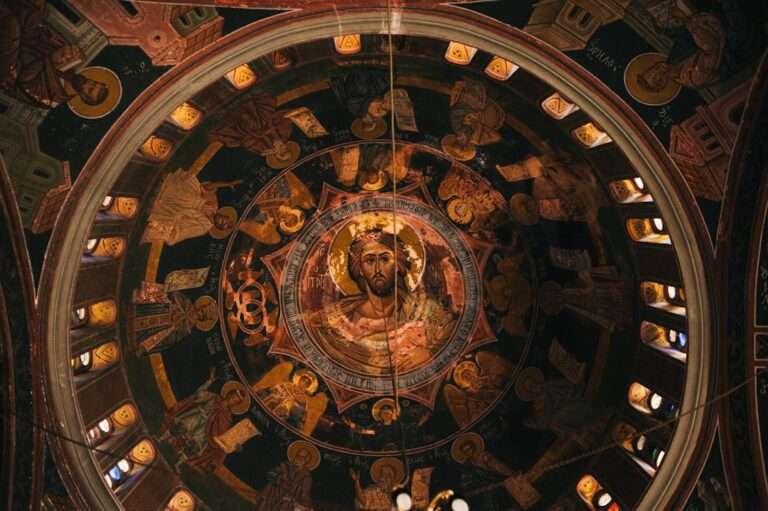What does the lion symbolize in global cultures?

The lion has long been recognized as a symbol of strength and power in various cultures and societies worldwide. Its muscular build, sharp claws, and powerful jaws contribute to its reputation as one of the strongest animals in nature. Lions are capable of taking down large prey and defending their territory against other predators, further solidifying their status as apex predators.
Many ancient civilizations revered the lion as a powerful and majestic creature, often associating it with the sun and viewing it as a representation of power and vitality. The lion’s roar is another significant aspect of its strength and dominance. This vocalization can be heard from up to 5 miles away and serves to establish territory and communicate with other pride members.
The deep, resonant sound of a lion’s roar is a clear indication of its power and authority within its environment. As a result, the lion has become a popular symbol of strength and power in various contexts, from ancient mythology to modern-day logos and emblems. Its image is frequently used to convey a sense of authority, dominance, and resilience.
In sports, the lion’s strength and power have made it a popular choice for team mascots and logos. Its fierce reputation translates well to competitive environments, inspiring fear and respect in opponents. Many sports teams worldwide have adopted the lion as their mascot, using its image to represent their strength and determination.
The lion’s symbolism of power and strength continues to resonate across different cultures and contexts, whether in nature, mythology, or modern applications.
Key Takeaways
- The lion is often seen as a symbol of strength and power due to its physical prowess and dominance in the animal kingdom.
- In many cultures, the lion is a symbol of royalty and leadership, representing qualities such as nobility, authority, and majesty.
- The lion is also a symbol of courage and bravery, often associated with the idea of facing challenges and adversity with fearlessness.
- As a symbol of protection and guardianship, the lion is often depicted as a guardian or protector of sacred spaces and individuals.
- The lion is also seen as a symbol of wisdom and intelligence, representing qualities such as insight, discernment, and strategic thinking.
- In some contexts, the lion is a symbol of ferocity and aggression, embodying the idea of assertiveness and assertive action.
- The lion is also seen as a symbol of spirituality and divine connection, often associated with qualities such as strength of spirit and connection to higher powers.
The Lion as a Symbol of Royalty and Leadership
The Historical Significance of the Lion as a Royal Symbol
The lion has long been regarded as a symbol of royalty and leadership, often depicted as a regal and majestic creature befitting of its royal associations. Throughout history, the lion has been used to represent kings, emperors, and other rulers, conveying their authority and legitimacy. In many ancient civilizations, the lion was seen as a symbol of divine kingship, with rulers often adopting the image of the lion to assert their power and dominance.
The Lion in Ancient Mythology and Folklore
The lion’s role as a symbol of royalty and leadership can be traced back to ancient mythology and folklore. In many cultures, the lion was associated with deities and gods, often depicted as a divine creature with supernatural powers. As a result, the lion became closely linked with the concept of kingship and was often used to represent the divine right of rulers to govern their people.
The Enduring Legacy of the Lion as a Symbol of Royalty
This association between the lion and royalty has persisted throughout history, with lions often featured in royal heraldry, coats of arms, and other symbols of authority. The lion’s image as a symbol of royalty and leadership is also reflected in popular culture and literature. In many fairy tales and fables, the lion is portrayed as a noble and dignified creature, often serving as a wise and benevolent ruler. This portrayal has further cemented the lion’s reputation as a symbol of leadership and authority, inspiring admiration and respect for its regal qualities.
The Lion as a Symbol of Courage and Bravery

The lion’s reputation as a symbol of courage and bravery is deeply rooted in its behavior and characteristics as a predator. As one of the top predators in the animal kingdom, the lion is known for its fearlessness in hunting large prey and defending its territory against rival predators. Its boldness in the face of danger has made it a powerful symbol of courage and bravery in various cultures and societies.
The lion’s courage is most evident in its hunting behavior, where it displays remarkable bravery in taking down prey much larger than itself. With its stealthy approach and lightning-fast attacks, the lion demonstrates incredible courage in confronting formidable opponents in the wild. This fearless attitude has earned the lion a reputation as a symbol of bravery, inspiring admiration for its ability to overcome adversity and confront challenges head-on.
In addition to its hunting prowess, the lion’s role as a protector of its pride further underscores its reputation as a symbol of courage. Male lions are known for their fierce defense of their territory and family, often risking their lives to ward off potential threats from rival males or other predators. This selfless act of bravery in protecting their pride has made the lion an enduring symbol of courage and valor, admired for its unwavering commitment to safeguarding those under its care.
The lion’s image as a symbol of courage and bravery has also been embraced in popular culture, where it is often portrayed as a heroic figure in literature, film, and art. Whether as the fearless protagonist in a story or as a representation of bravery in a work of art, the lion continues to inspire admiration for its courageous spirit and unwavering determination. Its enduring legacy as a symbol of courage serves as a reminder of the strength and resilience that can be found in facing adversity with bravery and fortitude.
The Lion as a Symbol of Protection and Guardianship
The lion’s role as a symbol of protection and guardianship is closely tied to its behavior as a social animal that forms strong bonds within its pride. In the wild, lions are known for their strong sense of community and their commitment to protecting their pride members from external threats. This innate instinct to safeguard their family members has made the lion an enduring symbol of protection and guardianship in various cultures around the world.
The lion’s protective nature is most evident in its role as a guardian of its territory, where it fiercely defends its pride against rival predators and other potential threats. Male lions, in particular, play a crucial role in patrolling their territory and ensuring the safety of their pride members from outside dangers. This unwavering commitment to protection has earned the lion a reputation as a symbol of guardianship, revered for its dedication to keeping those under its care safe from harm.
In addition to its role as a protector of its pride, the lion’s image as a symbol of guardianship is also reflected in its portrayal in art and mythology. In many ancient cultures, the lion was often depicted as a guardian figure, serving as a protective force against evil spirits or malevolent forces. Its powerful presence and watchful gaze were believed to ward off danger and provide reassurance to those seeking protection from harm.
The lion’s symbolism as a guardian has also been embraced in modern contexts, where it is often used to represent security and protection in various forms. From statues guarding entrances to buildings to emblems on shields or crests symbolizing protection, the lion’s image continues to evoke feelings of safety and security. Its enduring legacy as a symbol of guardianship serves as a reminder of the importance of protecting those who are vulnerable and ensuring their well-being in an uncertain world.
The Lion as a Symbol of Wisdom and Intelligence
The lion’s image as a symbol of wisdom and intelligence is rooted in its behavior as a highly strategic predator with keen instincts for survival. In the wild, lions are known for their calculated approach to hunting, using teamwork, patience, and cunning tactics to outmaneuver their prey. This strategic mindset has made the lion an enduring symbol of wisdom and intelligence, admired for its ability to navigate complex challenges with skillful precision.
The lion’s wisdom is most evident in its social structure within the pride, where individuals display remarkable intelligence in coordinating group activities such as hunting, raising offspring, and defending territory. Each member plays a specific role based on their strengths and abilities, demonstrating a high level of intelligence in understanding their environment and adapting their behavior accordingly. This cooperative mindset has earned the lion a reputation as a symbol of wisdom, revered for its ability to make informed decisions that benefit the entire pride.
In addition to its social intelligence, the lion’s image as a symbol of wisdom is also reflected in its portrayal in mythology and folklore. In many cultures, the lion was often associated with deities or legendary figures known for their wisdom and insight. Its regal appearance and dignified demeanor were seen as attributes befitting wise rulers or revered sages, further solidifying its reputation as a symbol of wisdom.
The lion’s symbolism as a representation of wisdom has also been embraced in modern contexts, where it is often used to convey intelligence and strategic thinking in various forms. From corporate logos representing astute decision-making to educational institutions using the lion as a mascot for academic excellence, the lion’s image continues to evoke feelings of wisdom and intellect. Its enduring legacy as a symbol of intelligence serves as a reminder of the value of thoughtful consideration and strategic planning in navigating life’s challenges with wisdom.
The Lion as a Symbol of Ferocity and Aggression

The Apex Predator: A Legacy of Fear and Respect
The lion’s image as a symbol of ferocity and aggression is deeply rooted in its behavior as an apex predator with formidable hunting skills. In the wild, lions are known for their fierce attacks on large prey animals, using their powerful jaws and sharp claws to bring down opponents with ruthless efficiency. This predatory behavior has made the lion an enduring symbol of ferocity and aggression, admired for its ability to assert dominance through sheer force.
Ferocity in Action: Hunting Tactics and Stealthy Approaches
The lion’s ferocity is most evident in its hunting tactics, where it displays remarkable aggression in pursuing prey with relentless determination. Its stealthy approach and lightning-fast attacks showcase an unparalleled level of ferocity that strikes fear into the hearts of potential victims. This aggressive mindset has earned the lion a reputation as a symbol of ferocity, revered for its ability to unleash raw power when confronting adversaries in the wild.
Artistic and Mythological Representations: A Legacy of Strength and Aggression
In addition to its hunting prowess, the lion’s image as a symbol of ferocity is also reflected in its portrayal in art and mythology. In many ancient cultures, the lion was often depicted as a fearsome creature associated with war gods or warrior deities known for their aggressive nature. Its imposing stature and commanding presence were seen as symbols of unyielding strength and unbridled aggression, further solidifying its reputation as a representation of ferocity.
Modern Embracement: A Symbol of Assertiveness and Determination
The lion’s symbolism as an emblem of ferocity has also been embraced in modern contexts, where it is often used to convey assertiveness and determination in various forms. From sports teams adopting the lion as their mascot to businesses using its image to project boldness and tenacity, the lion’s representation continues to evoke feelings of ferocity and aggression. Its enduring legacy as a symbol of raw power serves as a reminder of the primal instincts that drive individuals to assert themselves with unrelenting force when facing challenges.
The Lion as a Symbol of Spirituality and Divine Connection
The lion’s image as a symbol of spirituality and divine connection is deeply rooted in its portrayal in ancient mythology and religious beliefs. In many cultures around the world, the lion was often associated with deities or revered figures known for their spiritual significance. Its majestic appearance and commanding presence were seen as symbols of divine power and spiritual guidance, further solidifying its reputation as a representation of spirituality.
The lion’s role as a symbol of spirituality is most evident in its depiction in religious texts and folklore, where it is often revered as a sacred creature with supernatural attributes. In many ancient civilizations, the lion was associated with solar deities or celestial beings that embodied qualities such as strength, courage, and wisdom. Its regal demeanor and awe-inspiring presence were seen as manifestations of divine energy that inspired reverence among believers seeking spiritual enlightenment.
In addition to its association with deities, the lion’s symbolism as a representation of spirituality is also reflected in its portrayal in art and architecture. In many religious traditions, lions are often depicted in sacred spaces such as temples or shrines, serving as guardians or protectors against malevolent forces. Their powerful presence was believed to instill feelings of awe and reverence among worshippers seeking solace or divine intervention.
The lion’s symbolism as an emblem of spirituality has also been embraced in modern contexts, where it is often used to convey reverence and spiritual connection in various forms. From decorative motifs representing spiritual enlightenment to symbolic imagery evoking feelings of transcendence or inner peace, the lion’s representation continues to inspire feelings of spiritual awakening. Its enduring legacy as a symbol of divine connection serves as a reminder of the profound spiritual significance that can be found in embracing higher truths beyond earthly existence.
In conclusion, the symbolism associated with lions spans across various aspects such as strength & power; royalty & leadership; courage & bravery; protection & guardianship; wisdom & intelligence; ferocity & aggression; spirituality & divine connection. These symbols have been deeply ingrained into human culture throughout history across different civilizations around the world. The enduring legacy of lions’ symbolism continues to inspire admiration for their majestic qualities that resonate deeply within human consciousness.
FAQs
What is the lion a symbol of in global cultures?
The lion is often seen as a symbol of strength, courage, and leadership in many global cultures. It is also associated with royalty, power, and protection.
Which cultures consider the lion as a symbol of royalty?
The lion is considered a symbol of royalty in various cultures, including ancient Egypt, where it was associated with the pharaohs, and in European heraldry, where it is often depicted on coats of arms.
What does the lion symbolize in African cultures?
In African cultures, the lion is often seen as a symbol of bravery, wisdom, and protection. It is also associated with the sun and is considered a powerful and respected animal.
How is the lion symbolized in Chinese culture?
In Chinese culture, the lion is often depicted as a guardian and protector. Lion statues are commonly placed at the entrances of buildings and are believed to ward off evil spirits and bring good luck.
What does the lion symbolize in Hinduism?
In Hinduism, the lion is associated with the goddess Durga, who is often depicted riding a lion. The lion symbolizes power, strength, and fearlessness in the face of adversity.





